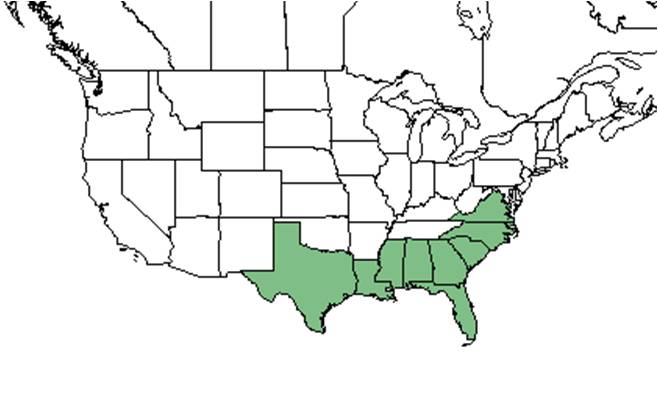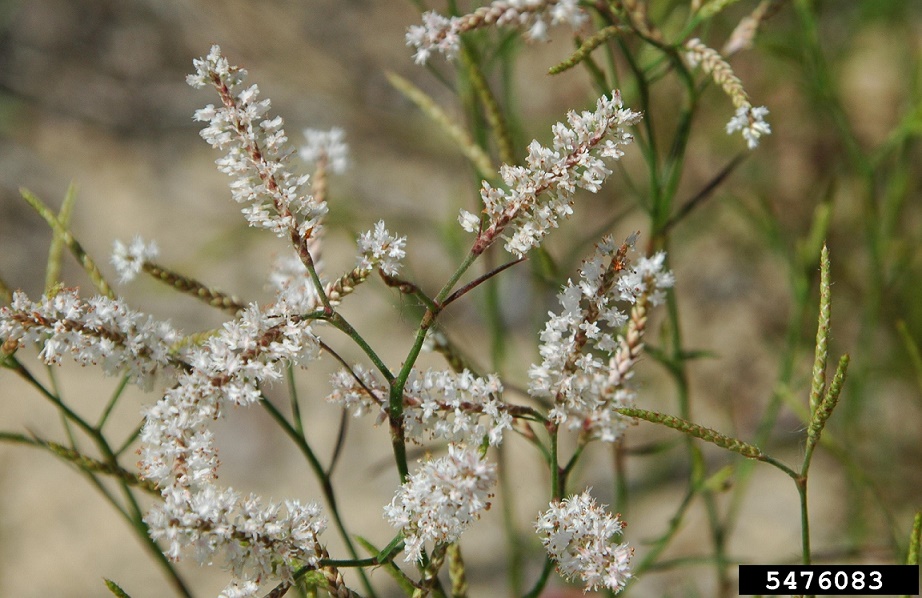Difference between revisions of "Polygonum polygamum"
Krobertson (talk | contribs) (→Taxonomic notes) |
HaleighJoM (talk | contribs) (→Ecology) |
||
| (9 intermediate revisions by 5 users not shown) | |||
| Line 20: | Line 20: | ||
Common name: October flower | Common name: October flower | ||
==Taxonomic notes== | ==Taxonomic notes== | ||
| − | Synonyms: ''Polygonella polygama | + | Synonyms: ''Polygonella polygama''; ''Polygonella polygama'' (Ventenat) Engelmann & A. Gray var. ''polygama'' |
There are three geographically distinct varieties: var. ''brachystachya'' is only found in southern and south-central Florida and appears to be the most unique of the three varieties; var. ''cromii'' occurs primarily in North and South Carolina; var. ''polygama'' is widely distributed and appears to be sympatric with var. ''croomii.''<ref name="Nesom">Nesom, G. L. and V. M. Bates (1984). "Reevaluations of Infraspecific Taxonomy in Polygonella (Polygonaceae)." Brittonia 36(1): 37-44</ref> | There are three geographically distinct varieties: var. ''brachystachya'' is only found in southern and south-central Florida and appears to be the most unique of the three varieties; var. ''cromii'' occurs primarily in North and South Carolina; var. ''polygama'' is widely distributed and appears to be sympatric with var. ''croomii.''<ref name="Nesom">Nesom, G. L. and V. M. Bates (1984). "Reevaluations of Infraspecific Taxonomy in Polygonella (Polygonaceae)." Brittonia 36(1): 37-44</ref> | ||
| Line 29: | Line 29: | ||
==Distribution== | ==Distribution== | ||
| − | ''P. polygamum'' is distributed throughout the Coastal Plain, from southeast Virginia to south-central Florida, west to Texas<ref name="eol">[[http://eol.org/pages/585573/details]] Encyclopedia of Life. Accessed: February 22, 2016</ref> | + | ''P. polygamum'' is distributed throughout the Coastal Plain, from southeast Virginia to south-central Florida, west to Texas.<ref name="eol">[[http://eol.org/pages/585573/details]] Encyclopedia of Life. Accessed: February 22, 2016</ref> |
==Ecology== | ==Ecology== | ||
===Habitat=== <!--Natural communities, human disturbed habitats, topography, hydrology, soils, light, fire regime requirements for removal of competition, etc.--> | ===Habitat=== <!--Natural communities, human disturbed habitats, topography, hydrology, soils, light, fire regime requirements for removal of competition, etc.--> | ||
| − | In the Coastal Plain in Florida, ''P. polygamum'' can occur in seasonally wet depressions with ''Hypericum tenuifolium'' and ''Paronychia chartacea''; and in xeric oak/saw palmetto scrubs. In disturbed areas it can be found in roadside ditches, clear-cut slash pine forests,wooded beach dunes; and dry sandy spoil material that has been pumped from the river during dredging operations<ref name="FSU">Florida State University Robert K. Godfrey Herbarium database. URL: [http://herbarium.bio.fsu.edu http://herbarium.bio.fsu.edu]. Last accessed: October 2015. Collectors: Loran Anderson, Wilson Baker, Angus Ghloson Jr., Robert K. Godfrey, Ann Johnson, Robert L. Lazor, Cecil R. Slaughter. States and Counties: Florida: Bay, Franklin, Holmes, Osceola. Compiled by Tall Timbers Research Station and Land Conservancy.</ref><ref name="Looney and Gibson 1995">Looney, P. B. and D. J. Gibson (1995). "The Relationship between the Soil Seed Bank and Above-Ground Vegetation of a Coastal Barrier Island." Journal of Vegetation Science 6(6): 825-836</ref> | + | In the Coastal Plain in Florida, ''P. polygamum'' can occur in seasonally wet depressions with ''Hypericum tenuifolium'' and ''Paronychia chartacea''; and in xeric oak/saw palmetto scrubs. In disturbed areas it can be found in roadside ditches, clear-cut slash pine forests,wooded beach dunes; and dry sandy spoil material that has been pumped from the river during dredging operations.<ref name="FSU">Florida State University Robert K. Godfrey Herbarium database. URL: [http://herbarium.bio.fsu.edu http://herbarium.bio.fsu.edu]. Last accessed: October 2015. Collectors: Loran Anderson, Wilson Baker, Angus Ghloson Jr., Robert K. Godfrey, Ann Johnson, Robert L. Lazor, Cecil R. Slaughter. States and Counties: Florida: Bay, Franklin, Holmes, Osceola. Compiled by Tall Timbers Research Station and Land Conservancy.</ref><ref name="Looney and Gibson 1995">Looney, P. B. and D. J. Gibson (1995). "The Relationship between the Soil Seed Bank and Above-Ground Vegetation of a Coastal Barrier Island." Journal of Vegetation Science 6(6): 825-836</ref> Associated species include ''Liatris laevigata, Hypericum tenuifolim, Paronychia chartacea'' and ''Palafoxia integrifolia''. Soil types include white sand and loamy sand.<ref name="FSU"/> |
===Phenology=== <!--Timing off flowering, fruiting, seed dispersal, and environmental triggers. Cite PanFlora website if appropriate: http://www.gilnelson.com/PanFlora/ --> | ===Phenology=== <!--Timing off flowering, fruiting, seed dispersal, and environmental triggers. Cite PanFlora website if appropriate: http://www.gilnelson.com/PanFlora/ --> | ||
| − | Flowers in September and October<ref name="FSU"/> seed mature in winter<ref name="etd">[[http://etd.fcla.edu/UF/UFE0041331/heather_a.pdf]]Accessed: February 22, 2016</ref> | + | Flowers in September and October<ref name="FSU"/> seed mature in winter.<ref name="etd">[[http://etd.fcla.edu/UF/UFE0041331/heather_a.pdf]]Accessed: February 22, 2016</ref> |
| + | |||
===Seed dispersal=== | ===Seed dispersal=== | ||
| − | + | This species disperses by gravity.<ref>Kirkman, L. Katherine. Unpublished database of seed dispersal mode of plants found in Coastal Plain longleaf pine-grasslands of the Jones Ecological Research Center, Georgia.</ref> | |
===Seed bank and germination=== | ===Seed bank and germination=== | ||
| − | Physical dormancy does not typically occur, however, some seeds possess a non-deep physiological dormancy<ref name="heather">Heather, A. E., H. E. Perez, et al. (2010). "Non-deep physiological dormancy in seeds of two Polygonella species with horticultural potential." HortScience 45(12): 1854-1858</ref> | + | Physical dormancy does not typically occur, however, some seeds possess a non-deep physiological dormancy.<ref name="heather">Heather, A. E., H. E. Perez, et al. (2010). "Non-deep physiological dormancy in seeds of two Polygonella species with horticultural potential." HortScience 45(12): 1854-1858</ref> |
<!--===Fire ecology===--><!--Fire tolerance, fire dependence, adaptive fire responses--> | <!--===Fire ecology===--><!--Fire tolerance, fire dependence, adaptive fire responses--> | ||
| + | |||
===Pollination=== | ===Pollination=== | ||
| − | + | ''Polygonum polygamum'' has been observed with ground-nesting bees from the Andrenidae family such as '' Perdita polygonellae''.<ref>Discoverlife.org [https://www.discoverlife.org/20/q?search=Bidens+albaDiscoverlife.org|Discoverlife.org]</ref> | |
| − | + | Additionally, ''P. polygamum'' has been observed at the Archbold Biological Station to host the following species:<ref name="Deyrup 2015">Deyrup, M.A. and N.D. 2015. Database of observations of Hymenoptera visitations to flowers of plants on Archbold Biological Station, Florida, USA.</ref> | |
| − | + | Plasterer bees from the family Colletidae: ''Colletes mandibularis'' | |
| − | + | Sweat bees from the family Halictidae: ''Augochlorella aurata, Augochloropsis anonyma, A. metallica, Halictus poeyi, Lasioglossum nymphalis, L. placidensis, Sphecodes heraclei'' | |
| − | + | Wasps from the family Leucospididae: ''Leucospis slossonae'' | |
| − | + | Spider wasps from the family Pompilidae: ''Anoplius marginalis, Episyron conterminus posterus'' | |
| − | Vespidae: ''Eumenes smithii, Leptochilus republicanus, Pachodynerus erynnis'' | + | Thread-waisted wasps from the family Sphecidae: ''Gorytes deceptor, Oxybelus decorosum, Tachytes distinctus, T. validus'' |
| − | <!--=== | + | |
| + | Wasps from the family Vespidae: ''Eumenes smithii, Leptochilus republicanus, Pachodynerus erynnis'' | ||
| + | <!--===Herbivory and toxicology===<!--Common herbivores, granivory, insect hosting, poisonous chemicals, allelopathy, etc--> | ||
<!--===Diseases and parasites===--> | <!--===Diseases and parasites===--> | ||
| − | ==Conservation and | + | |
| − | == | + | ==Conservation, cultivation, and restoration== |
| + | |||
| + | ==Cultural use== | ||
==Photo Gallery== | ==Photo Gallery== | ||
<gallery widths=180px> | <gallery widths=180px> | ||
Latest revision as of 14:15, 15 July 2022
| Polygonum polygamum | |
|---|---|

| |
| Synonym Polygonella polygama shown, Photo by Karan A. Rawlins, University of Georgia, Bugwood.org | |
| Scientific classification | |
| Kingdom: | Plantae |
| Division: | Magnoliophyta - Flowering plants |
| Class: | Magnoliopsida – Dicotyledons |
| Order: | Caryophyllales |
| Family: | Polygonaceae |
| Genus: | Polygonella |
| Species: | P. polygamum |
| Binomial name | |
| Polygonum polygamum (Vent.) Engelm. & A. Gray | |

| |
| Natural range of Polygonum polygamum from USDA NRCS Plants Database. | |
Common name: October flower
Contents
Taxonomic notes
Synonyms: Polygonella polygama; Polygonella polygama (Ventenat) Engelmann & A. Gray var. polygama
There are three geographically distinct varieties: var. brachystachya is only found in southern and south-central Florida and appears to be the most unique of the three varieties; var. cromii occurs primarily in North and South Carolina; var. polygama is widely distributed and appears to be sympatric with var. croomii.[1]
Description
A description of Polygonum polygamum is provided in The Flora of North America.
Distribution
P. polygamum is distributed throughout the Coastal Plain, from southeast Virginia to south-central Florida, west to Texas.[2]
Ecology
Habitat
In the Coastal Plain in Florida, P. polygamum can occur in seasonally wet depressions with Hypericum tenuifolium and Paronychia chartacea; and in xeric oak/saw palmetto scrubs. In disturbed areas it can be found in roadside ditches, clear-cut slash pine forests,wooded beach dunes; and dry sandy spoil material that has been pumped from the river during dredging operations.[3][4] Associated species include Liatris laevigata, Hypericum tenuifolim, Paronychia chartacea and Palafoxia integrifolia. Soil types include white sand and loamy sand.[3]
Phenology
Flowers in September and October[3] seed mature in winter.[5]
Seed dispersal
This species disperses by gravity.[6]
Seed bank and germination
Physical dormancy does not typically occur, however, some seeds possess a non-deep physiological dormancy.[7]
Pollination
Polygonum polygamum has been observed with ground-nesting bees from the Andrenidae family such as Perdita polygonellae.[8]
Additionally, P. polygamum has been observed at the Archbold Biological Station to host the following species:[9]
Plasterer bees from the family Colletidae: Colletes mandibularis
Sweat bees from the family Halictidae: Augochlorella aurata, Augochloropsis anonyma, A. metallica, Halictus poeyi, Lasioglossum nymphalis, L. placidensis, Sphecodes heraclei
Wasps from the family Leucospididae: Leucospis slossonae
Spider wasps from the family Pompilidae: Anoplius marginalis, Episyron conterminus posterus
Thread-waisted wasps from the family Sphecidae: Gorytes deceptor, Oxybelus decorosum, Tachytes distinctus, T. validus
Wasps from the family Vespidae: Eumenes smithii, Leptochilus republicanus, Pachodynerus erynnis
Conservation, cultivation, and restoration
Cultural use
Photo Gallery
Flowers of Polygonella polygama Photo by Karan A. Rawlins, University of Georgia, Bugwood.org
References and notes
- ↑ Nesom, G. L. and V. M. Bates (1984). "Reevaluations of Infraspecific Taxonomy in Polygonella (Polygonaceae)." Brittonia 36(1): 37-44
- ↑ [[1]] Encyclopedia of Life. Accessed: February 22, 2016
- ↑ 3.0 3.1 3.2 Florida State University Robert K. Godfrey Herbarium database. URL: http://herbarium.bio.fsu.edu. Last accessed: October 2015. Collectors: Loran Anderson, Wilson Baker, Angus Ghloson Jr., Robert K. Godfrey, Ann Johnson, Robert L. Lazor, Cecil R. Slaughter. States and Counties: Florida: Bay, Franklin, Holmes, Osceola. Compiled by Tall Timbers Research Station and Land Conservancy.
- ↑ Looney, P. B. and D. J. Gibson (1995). "The Relationship between the Soil Seed Bank and Above-Ground Vegetation of a Coastal Barrier Island." Journal of Vegetation Science 6(6): 825-836
- ↑ [[2]]Accessed: February 22, 2016
- ↑ Kirkman, L. Katherine. Unpublished database of seed dispersal mode of plants found in Coastal Plain longleaf pine-grasslands of the Jones Ecological Research Center, Georgia.
- ↑ Heather, A. E., H. E. Perez, et al. (2010). "Non-deep physiological dormancy in seeds of two Polygonella species with horticultural potential." HortScience 45(12): 1854-1858
- ↑ Discoverlife.org [3]
- ↑ Deyrup, M.A. and N.D. 2015. Database of observations of Hymenoptera visitations to flowers of plants on Archbold Biological Station, Florida, USA.
